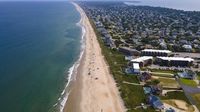On the windswept barrier islands of North Carolina’s Outer Banks, the familiar rhythm of summer tourism has been upended by the relentless approach of Hurricane Erin. As of August 19, 2025, Erin—a formidable Category 2 hurricane—remained hundreds of miles offshore, yet its far-reaching effects have been impossible to ignore. The storm’s immense energy has sent waves as high as 20 feet crashing against vulnerable sand dunes, leaving both residents and vacationers bracing for a different kind of summer week.
North Carolina Governor Josh Stein didn’t mince words as he declared a state of emergency: “To folks on the coast, now is the time to prepare,” he warned on Tuesday, according to ABC News. The Outer Banks, a slender chain of barrier islands famed for their beauty and resilience, have been placed under a tropical storm warning, with mandatory evacuations ordered for Hatteras and Ocracoke islands. The threat is not a direct landfall, but rather the raw force of nature—waves, storm surge, and flooding—that could isolate these islands for days or weeks.
For the roughly 3,500 year-round residents of the Outer Banks, the prospect of isolation is nothing new. As Reide Corbett, executive director of the Coastal Studies Institute, explained to the Associated Press, “We haven’t seen waves of that size in a while and the vulnerable spots have only gotten weaker in the past five years.” The Outer Banks are, after all, defined by water—a narrow ribbon of sand, sometimes just a few feet above sea level, perched between the vast Atlantic Ocean to the east and Pamlico Sound to the west. The only access to Hatteras Island is N.C. Highway 12, a road so fragile that locals joke about its reliability with T-shirts reading, “One road on. One road off (sometimes).”
Officials have good reason to be cautious. The N.C. Department of Transportation spends over $1 million each year just to keep N.C. 12 open, and repairs after storms have cost about $50 million over the past decade, as reported by the Associated Press. When storms hit, ocean water and sand can cover or even break up the pavement, sometimes creating new inlets that require temporary bridges. After hurricanes Isabel in 2003 and Irene in 2011, ferry service was the only way to access Hatteras Island for up to two months. Even routine Nor’easters can close the road for days. This week, with Hurricane Erin’s waves threatening to wash out sections of N.C. 12, officials have acted early—evacuating both residents and the tens of thousands of vacationers who flock to the islands every summer.
For newcomers like Holly Andrzejewski, who had just purchased the historic Atlantic Inn on Hatteras Island, the timing couldn’t be more challenging. Andrzejewski told the Associated Press that she and her family had just begun preparing for their first guests when the storm warnings forced them to reschedule. “It’s just one of those things where you know this is always a possibility and it could happen, and you just make the best out of it. Otherwise you wouldn’t live at the beach,” she said. Andrzejewski and her family have stocked up on essentials—generators, water, flashlights—and will stay behind to watch over their property, a decision echoed by many longtime residents who have weathered storms before.
The impact of Hurricane Erin is being felt far beyond North Carolina. Dangerous surf, rip currents, and high winds have prompted beach closures and swimming bans up and down the East Coast. According to ABC News, more than 50 people were rescued from the ocean at Wrightsville Beach, North Carolina, on Monday, August 18. Fortunately, there were no injuries or fatalities, but the message from officials has been clear: stay out of the water. New Jersey Governor Phil Murphy put it bluntly on Tuesday: “I would just say to you, flat out, don’t go in the water.” Swimming bans have been enacted at popular destinations from Rehoboth Beach, Delaware, and Wildwood, New Jersey, to New York City, where beaches are closed for swimming on Wednesday and Thursday. The National Weather Service has issued a high rip current risk through at least midweek, with wave heights expected to reach 8 to 15 feet and worsening as the storm draws closer.
The timing couldn’t be worse for local businesses. The evacuations and beach closures come at the peak of tourist season, a crucial period for the local economy. Dare County, which includes much of the Outer Banks, brings in an estimated $2 billion in tourism revenue each year. For business owners like Tommy Hutcherson, who runs the only grocery store on Ocracoke Island, the uncertainty is a familiar burden. “But you just never know. I felt the same way about Dorian and we really got smacked,” Hutcherson recalled, referencing the devastation wrought by Hurricane Dorian in 2019. The community has bounced back before, but the specter of several days of heavy surf, high winds, and impassable roads is always daunting.
The environmental toll is also mounting. Erosion and rising sea levels are constant threats to the Outer Banks, where most land sits just a few feet above the ocean. Since 2020, more than a dozen homes in Rodanthe have been claimed by the sea, and officials worry that at least two more unoccupied houses could be lost if Erin’s waves are as strong as predicted. The barrier islands have always been shaped by storms, but as the planet warms and polar ice melts, the challenges of maintaining this unique landscape are growing. Every inch of sand matters, and each major storm brings the possibility of permanent change.
Despite the hardships, the Outer Banks community is known for its resilience and camaraderie. Residents like Shelli Miller Gates, who first worked on the islands in the late 1970s, have seen neighbors band together time and again when storms sever their connection to the mainland. “I love the water. I love the wildness of it. It’s the way I want to live my life,” Gates told the Associated Press. The shorthand “OBX” is a source of pride, emblazoned on license plates and souvenirs, a symbol of the community’s enduring spirit. “There’s things everywhere. There’s earthquakes and blizzards and floods. Look at the poor people out in western North Carolina. There are so many things that can happen to you. I feel like you have to find the place that feels like home.”
As Hurricane Erin makes its closest pass to the Outer Banks on Thursday, August 21, bringing heavy rain and strong winds before heading out to sea, the people of the Outer Banks—residents and business owners alike—are reminded yet again of the delicate balance between nature’s beauty and its power. For now, they wait, watch, and hope that this storm, like so many before it, will pass without leaving a lasting scar.





